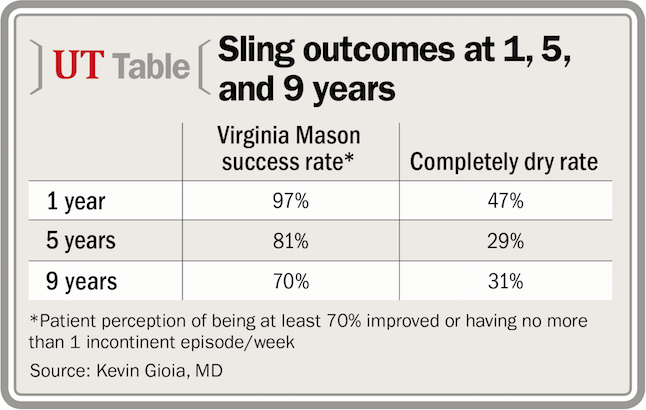Article
Long-term benefits observed with sling procedures
Author(s):
The three most commonly performed sling procedures exhibit long-term success, according to a recent observational study presented at the AUA annual meeting in New Orleans.
New Orleans-The three most commonly performed sling procedures exhibit long-term success, according to a recent observational study presented at the AUA annual meeting in New Orleans.
In addition, patients treated with mid-urethral or pubovaginal slings for stress urinary incontinence maintained positive outcomes up to 10 years after surgery.
Read: Low provider volume raises mesh removal risk
“In our complex heterogeneous population, we demonstrated results comparable to those previously reported in large randomized studies. Regardless of sling type, the majority of patients maintained subjective improvement up to 10 years after sling surgery,” said lead author Kevin Gioia, MD, a fellow in female pelvic medicine and reconstructive urologic surgery at Virginia Mason Medical Center in Seattle.
NEXT: Long-term durability data limited

Long-term durability data limited
Despite the importance of this information, according to Dr. Gioia, data on the durability of sling procedures longer than 5 years after surgery are limited.
“This information is frequently requested by patients during preoperative counseling. We all know it can be very valuable when we’re counseling our patients,” said Dr. Gioia, who worked on the study with Kathleen Kobashi, MD, and colleagues.
Related: Mid-urethral slings demonstrate efficacy, few adverse effects
A retrospective review of the prospectively collected, longitudinal pelvic floor database identified 901 patients who underwent retropubic mid-urethral sling, transobturator mid-urethral sling, or autologous pubovaginal sling surgery. Patients were also required to have completed at least 1 post-op questionnaire within the 10-year follow-up period.
“We defined success as either completely dry or our institution’s definition, the VM [Virginia Mason] success, which is the patient’s perception of being at least 70% improved or experiencing no more than one incontinent episode per week,” said Dr. Gioia.
NEXT: Satisfaction scores
Satisfaction scores were also recorded on a scale of 0 to 10, with greater than 7 considered satisfied.
Following retropubic procedures, VM success rates were 97%, 81%, and 70%, at 1, 5, and 9 years, respectively, and completely dry rates were 47%, 29%, and 31%.
Also see - Best of AUA 2015: Female Urology/Incontinence/Urodynamics
“Completely dry rates are in the 30%-60% range, which is consistent with that previously reported in literature. VM success is higher as it is less stringent, albeit greater than 75% of patients were successful at 10 years plus. We were pleased to find that, although this is not longitudinal data, at any given time point the success rate and the completely dry rate remain respectable,” Dr. Gioia said.
Although completely dry rates were lower for transobturator outcomes than retropubic, Dr. Gioia noted that a comparison cannot be made here as this was not a randomized trial.
“These are two separate patient populations. Additionally, these numbers are similar to other known studies. VM success and satisfaction outcomes are still very robust across the board,” he said.
NEXT: Pubovaginal sling outcomes ‘respectable’
Pubovaginal sling outcomes ‘respectable’
Finally, outcomes for pubovaginal slings, despite lower initial leak-point pressures for patients and prior mesh erosions or complications with multiple, prior surgeries, were respectable, he said.
“Completely dry rates were reasonable, ranging from 20% to 60%. VM success is high at every time point, and what’s most striking here is the very high patient satisfaction, particularly greater than 90% at greater than 10 years. This is a good reference point to keep in mind when counseling our patients because these tend to be our most complex patients.”
According to Dr. Gioia, these results provide the surgeon with a tool for counseling patients preoperatively based on a target population representative of a high-volume referral center.
“If patients are completely dry following mid-urethral sling surgery, our data indicate that they will be dry for greater than 5 years after transobturator and greater than 8 years following retropubic surgery,” he said.
Further studies will allow for more accurate characterization of this population in order to better predict long-term outcomes, he concluded.
Dr. Kobashi has worked on a scientific study/trial for Cook Myosite and has served as a consultant/adviser and meeting participant/lecturer for Allergan and Medtronic.
More from Urology Times:
Blog: Practice ‘efficiency’ is not a dirty word but a noble goal
Alpha-blocker may have benefit in larger stones
Mini-laparoscopy advances: Where does urology fit?
Subscribe to Urology Times to get monthly news from the leading news source for urologists.
















